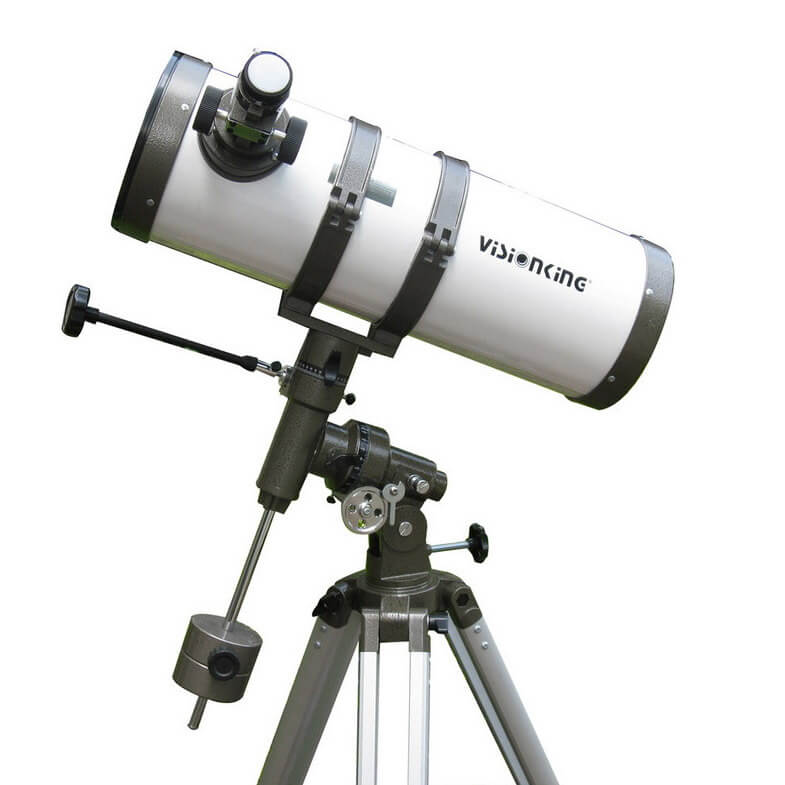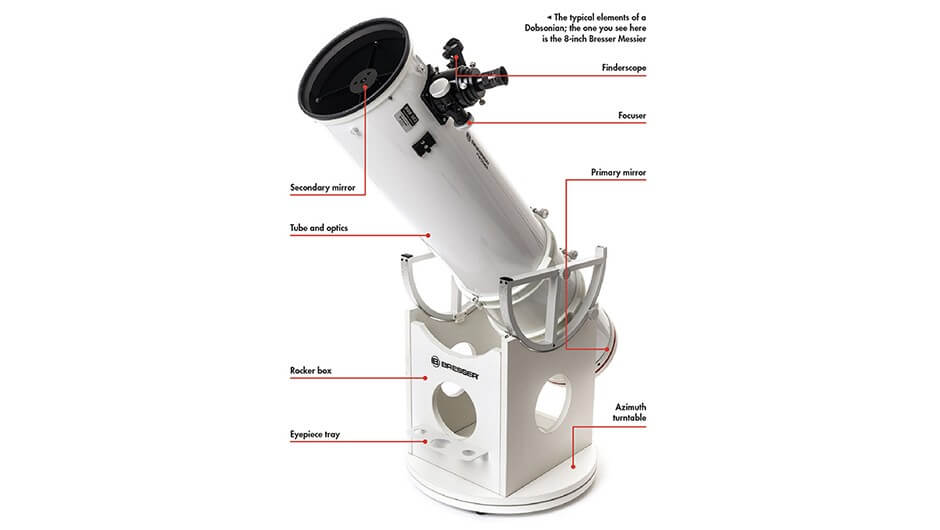There are several types of telescope mounts. The types of telescope mount that you pick should be determined by what you plan to do with your scope. Your sky viewing experience will vary depending on the type of mount that your telescope rests on.
For example, an EQ-mounted Newtonian reflector is best for nighttime stargazing and watching deep space objects. An alt-az mounted Newtonian reflector is best for wide-field sky viewing of deep space objects and planets.
[toc]
21 Types Of Telescope Mounts That You Might Not Know
A telescope mount is a mechanical structure that supports a telescope. Telescope mounts are designed to support the mass of the telescope and allow for accurate pointing of the instrument.
So what are you going to be using your telescope for? What type of mount should you get? Below is a list of the types of mounts that exist and what they do best:
1. Altazimuth Mounts
It is also called altitude-azimuth mount. It is the simplest design of telescope mounts that permits motion of the instrument in altitude (up-down rotation) and azimuth (left-right).
An altazimuth mounted scope can be pushed or pulled around its polar axis to keep objects centred as the Earth changes its position beneath the night sky. This type of mount is typically use on a small refractor or reflector telescope.
It has slow-motion controls which allow for fine tracking control and can easily track objects because it moves just like people naturally move around things by tilting their head from side to side.

2. Equatorial Mounts
It is also called the equatorial mount or ecliptic mount. This type of telescope mount uses one axis that is aligned to a celestial pole, while a second rotates perpendicularly to the first at its fixed pivot point.Once aligned, this polar axis will rotate in a circular motion upon any movement of the instrument.
This mount is designed to counter the rotation of the Earth. The telescope can point towards a near or distant object by rotating the scope on its stationary axis at a constant speed. This type of mount requires time and patience once you have it set up for your first use, but after that, it is easy to use.

3. Dobsonian Mounts
It is a simple alt-azimuth mounted Newtonian reflector with altitude on an altitude bearing and azimuth on a rotating arm. The design was created by John Dobson in 1965, originally meant to be easy to use, but it does require precise collimation for precise pointing of the telescope’s eyepiece.
A dovetail bar similar in size to the optical tube assembly can be moved up/down along the side of the mounting head to accommodate both small-aperture instruments and large-aperture instruments at their optimal positions.
This type of telescope mount works well for beginners because most telescopes come with this type of mount, which makes them very affordable since most telescopes are relatively inexpensive. It is typically used with large aperture Newtonian scopes and Dobsonian-style telescopes.

4. Pier-based Telescope Mounts
It usually has a heavy tripod on the ground and weights at all four legs of the tripod to keep it stable on an elevated surface such as a pier or platform that’s on the ground, which supports the telescope on its pier, pedestal, or tripod and allows for rotation of instruments (EQ).
The amount of time and effort it takes to set up this type of mount varies depending on what you use for support and how sturdy it is. Setting up can be difficult if everything isn’t quite level. This type of mount works well with EQ telescopes because they have slow-motion controls which allow you to track objects easily in addition to keeping them centred in the eyepiece for a clear, steady view.
5. Direct Drive Telescope Mounts
It is also called a direct drive or go-to telescope mount. With this type of telescope mount, the telescope will move whenever you push a button. It makes star hopping much easier because you can just centre your object in the eyepiece and press “go-to” on the hand controller to automatically track that object.
6. Equatorial Fork Mounts
This type of telescope mount works like an equatorially mounted dipole, so it requires tracking in both the right ascension and declination axis to keep objects centred in your field of view during exposures or while viewing them for a clear, steady image.
If you understand how the Earth moves around its axis, then you know how this scope works because it tracks along one axis just like people do when they walk forward on one side of their body while tilting their head from side to side to shift between walking straight ahead and looking down at where they’re going.
It can be found to be much easier to use than an equatorially mounted reflector because it requires less time to set up, but the difficulty level varies depending on what telescope you have and how big or heavy it is. This mount works well with EQ telescopes because they have slow-motion controls which allow you to track objects easily in addition to keeping them centred in the eyepiece for a clear, steady view.
7. German Equatorial Mouths (GEM)
It’s like an equatorial mount, but it has two axes known as R.A and Dec that enable you to track objects in the sky easily with motor-driven slow-motion controls (slow-motion controls allow you to track objects in the sky more precisely).
This type of telescope mount works well for beginners who are looking for ease in use in addition to affordability because most telescopes come with this type of mount, which makes them very affordable.
8. Parabolic Mouths
It consists of one or both axes that are designed to rotate around an open cone at its base, much like the Earth rotates about its polar axis. They are best suited for telescopes that use long focal length objectives as it works well with reflectors/refractors instead of reflectors since their light path is made through a glass mirror/lens instead of being reflected by a metal mirror.
It’s recommended to have a parabolic mount if you’re going for an instrument with a high focal ratio, but they are more expensive than the other types of telescope mounts.
It performs slightly better when tracking objects since it enables precise centering, but is considerably harder to use due to the need for periodic re-alignment and is not suited well for large instruments or heavy scopes that require a lot of time and patience setting up.
9. Centre Balanced Equatorial Mounts
It’s a telescope mount that uses one or both axes which can be turned by gear that allows you to track objects easily in addition to having a precise polar axis alignment that enables a view of objects with a minimum vibration time.
This type of telescope mount works well for beginners who are looking for ease of use and affordability but is more expensive than the EQ/fork-mounted telescopes because they come from the manufacturer with higher prices in addition to requiring quite a bit of care when using them.
For example an average size weight of around 60 lbs., if it was not designed properly, will cause misalignment and vibrations while viewing which could damage your precious instrument.
This telescope mount requires periodic re-alignment, but it’s a good choice for beginners because you can easily re-align the polar axis by simply moving your telescope tube slightly. It is best suited for astrographs and large telescopes that have longer focal ratios because tracking objects will be easier due to their precise movements.
10. Portable English Mounts
An alt-azimuth mount is a type of telescope which uses one or both axes to move the optical tube in altitude and azimuth. It’s best suited for an instrument that weighs around 50 lbs., but it works well with telescopes that weigh up to 100 lbs. because it allows you to track objects much easier.
If accurately polar aligned, this type of mount does not require re-alignment when tracking an object because its movement in altitude matches Earth’s rotation in addition to allowing you to track objects in the sky much faster due take less time when adjusting the telescope’s position.
However, it’s not recommended for trackers or beginners because you need to use both hands when manually moving your instrument in altitude and azimuth making it harder to track objects depending on your location concerning Earth’s poles.
Despite being easier to set up and use, this type of mount isn’t well suited for large telescopes due to poor stability which provides poor tracking performance under high magnification levels which makes viewing faint objects very difficult.
21. Camera Tracking Mounts
Also known as auto-tracking mounts. This type of telescope mount works with a clock drive that rotates the telescope at the same rate as Earth’s rotation which enables you to track objects much easier when your scope has tracking motors and power supply for this purpose.
It is best suited for large telescopes because it is well balanced and can support heavy instruments, but it also works well for smaller telescopes weighing less than 90 lbs. Although, they are relatively easy to use and set up which makes them suitable for beginners or astrophotography enthusiasts who don’t want to invest too much money in professional equipment.
On the other hand, this type of mount performs poorly when used in altazimuth mode because its movements are restricted only by the counterweight bar which causes a lot of problems when tracking objects in both altazimuth and equatorial mode.
But, it works great for any type of telescope because you can set up your telescope anywhere you want by simply rotating the mount to match Earth’s rotation which makes astrophotography much easier without being restricted only within the polar alignment area.
However, if improperly set up, this mount could cause significant vibration time while viewing objects making it difficult to use high magnifications due they provide accurate readings and stability at the same time.
Overall slow tracking speeds could damage your instrument depending on how long you’ve been using it. Therefore, if looking for a stable mount that works best with large or heavy telescopes I recommend going with a German Equatorial Mount.
Types Of Telescope Mounts – Conclusion
There are many types of telescope mounts, each with its pros and cons. Azimuth mounts provide easy viewing but are problematic when tracking objects. Equatorial mounts are slow to use but provide excellent tracking abilities. German equatorial mounts are good for large telescopes, while portable English mounts work well with small telescopes.